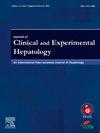Gut Microbiota and Genetic Polymorphisms Appear to Drive Disease Expression of Nonalcoholic Fatty Liver Disease in Lean Individuals
IF 3.3
Q2 GASTROENTEROLOGY & HEPATOLOGY
Journal of Clinical and Experimental Hepatology
Pub Date : 2025-01-13
DOI:10.1016/j.jceh.2025.102503
引用次数: 0
Abstract
Background/Objectives
There are very few comparative studies worldwide between ‘lean’ and ‘nonlean/obese nonalcoholic fatty liver disease (NAFLD)’ patients analyzing the differences in gut microbiome, genotype, and serum bile acids. Our aim was to compare the genotype, gut microbiome, bile acid profile, and metabolic patterns of lean NAFLD and obese NAFLD patients with special reference to hepatic fibrosis.
Methods
Both lean and obese NAFLD patients diagnosed by ultrasonography along with matched controls were included. Genotyping, fecal microbiome analysis and estimation of serum total bile acid levels were done for patients as well as controls.
Results
Biochemical and metabolic patterns of lean and obese NAFLD patients were comparable. Lean NAFLD patients had lower fasting plasma glucose (FPG) and homoeostasis model assessment-insulin resistance (HOMA-IR), although the proportions of patients having elevated HOMA-IR and metabolic syndrome (MS) were comparable. Noninvasive scores of liver fibrosis were also comparable. A greater proportion of lean NAFLD patients had the PNPLA3 rs738409 (G/G) genotype. However, there was no association of genetic polymorphisms with steatosis or fibrosis. Nonlean and lean NAFLD patients had comparable serum total bile acid levels. On microbiome analysis, lean NAFLD patients were found to have distinct expression of bacterial species while beta diversity was found to be significantly different across all groups.
Conclusion
Lean NAFLD patients were found to have the PNPLA3 rs738409 (G/G) genotype. Lean NAFLD patients were also found to have unique gut microbial signatures, while beta diversity significantly differed across all groups. Differential expression of gut microbiota and genetic polymorphisms could underlie the pathogenesis of lean NAFLD.

肠道微生物群和遗传多态性似乎驱动了瘦人非酒精性脂肪肝的疾病表达
背景/目的在世界范围内,“瘦”型和“非瘦/肥胖非酒精性脂肪肝”(NAFLD)患者之间分析肠道微生物群、基因型和血清胆汁酸差异的比较研究很少。我们的目的是比较瘦型NAFLD和肥胖NAFLD患者的基因型、肠道微生物群、胆酸谱和代谢模式,特别是肝纤维化。方法采用超声诊断的瘦型和肥胖型NAFLD患者及对照组。对患者和对照组进行基因分型、粪便微生物组分析和血清总胆汁酸水平评估。结果瘦型和肥胖型NAFLD患者的生化和代谢模式具有可比性。精益NAFLD患者的空腹血糖(FPG)和稳态模型评估-胰岛素抵抗(HOMA-IR)较低,尽管HOMA-IR升高和代谢综合征(MS)的患者比例相当。肝纤维化的无创评分也具有可比性。更大比例的瘦型NAFLD患者具有PNPLA3 rs738409 (G/G)基因型。然而,遗传多态性与脂肪变性或纤维化没有关联。非瘦肉型和瘦肉型NAFLD患者血清总胆汁酸水平相当。在微生物组分析中,发现瘦弱NAFLD患者有不同的细菌种类表达,而β多样性在所有组中都有显著差异。结论精益NAFLD患者存在PNPLA3 rs738409 (G/G)基因型。瘦型NAFLD患者也被发现具有独特的肠道微生物特征,而β多样性在所有组之间存在显著差异。肠道菌群和遗传多态性的差异表达可能是瘦型NAFLD发病机制的基础。
本文章由计算机程序翻译,如有差异,请以英文原文为准。
求助全文
约1分钟内获得全文
求助全文
来源期刊

Journal of Clinical and Experimental Hepatology
GASTROENTEROLOGY & HEPATOLOGY-
CiteScore
4.90
自引率
16.70%
发文量
537
审稿时长
64 days
 求助内容:
求助内容: 应助结果提醒方式:
应助结果提醒方式:


